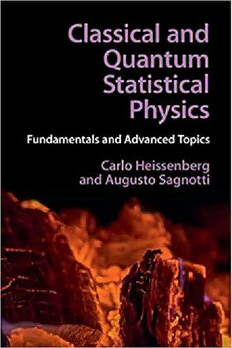Table Of ContentClassicalandQuantumStatisticalPhysics
Statisticalphysicsexaminesthecollectivepropertiesoflargeensemblesofparticles,
andisapowerfultheoreticaltoolwithimportantapplicationsacrossmanydifferent
scientific disciplines. This book provides a detailed introduction to classical and
quantum statistical physics, including links to topics at the frontiers of current
research. The first part of the book introduces classical ensembles, provides an
extensive review of quantum mechanics, and explains how their combination leads
directly to the theory of Bose and Fermi gases. It contains a detailed analysis of
the quantum properties of matter and introduces the exotic features of vacuum
fluctuations. The second part discusses more advanced topics such as the two-
dimensional Ising model and quantum spin chains. This modern text is ideal for
advanced undergraduate and graduate students interested in the role of statistical
physics in current research. One hundred and forty homework problems reinforce
keyconceptsandfurtherdevelopreaders’understandingofthesubject.
CarloHeissenberg is a postdoctoral scholar at the Nordic Institute for Theoretical
Physics (Nordita) in Stockholm, and at Uppsala University. He received his PhD
from Scuola Normale Superiore in Pisa, with a thesis on asymptotic symmetries
and higher spin theories, and his research is now focused on the interface between
scatteringamplitudesandgravitationalwaves.
AugustoSagnottiisProfessorofTheoreticalPhysicsatScuolaNormaleSuperioreand
has taught the Statistical Physics course there since 2017. His research is focused
ongravitationalphysicsandconformalfieldtheory,andhispioneeringcontribution
ledtotheintroduction oforientifoldvacua instringtheory.Heisarecipientofthe
HumboldtResearchAward.
Classical and Quantum
Statistical Physics
Fundamentals and Advanced Topics
CARLO HEISSENBERG
NordicInstituteforTheoreticalPhysicsandUppsalaUniversity
AUGUSTO SAGNOTTI
ScuolaNormaleSuperiorePisaandIstitutoNazionalediFisicaNucleare(INFN)
UniversityPrintingHouse,CambridgeCB28BS,UnitedKingdom
OneLibertyPlaza,20thFloor,NewYork,NY10006,USA
477WilliamstownRoad,PortMelbourne,VIC3207,Australia
314–321,3rdFloor,Plot3,SplendorForum,JasolaDistrictCentre,NewDelhi–110025,India
103PenangRoad,#05–06/07,VisioncrestCommercial,Singapore238467
CambridgeUniversityPressispartoftheUniversityofCambridge.
ItfurtherstheUniversity’smissionbydisseminatingknowledgeinthepursuitof
education,learning,andresearchatthehighestinternationallevelsofexcellence.
www.cambridge.org
Informationonthistitle:www.cambridge.org/9781108844628
DOI:10.1017/9781108952002
©CarloHeissenbergandAugustoSagnotti2022
Thispublicationisincopyright.Subjecttostatutoryexception
andtotheprovisionsofrelevantcollectivelicensingagreements,
noreproductionofanypartmaytakeplacewithoutthewritten
permissionofCambridgeUniversityPress.
Firstpublished2022
AcataloguerecordforthispublicationisavailablefromtheBritishLibrary.
LibraryofCongressCataloging-in-PublicationData
Names:Heissenberg,Carlo,author.|Sagnotti,Augusto,other.
Title:Classicalandquantumstatisticalphysics:Fundamentalsandadvancedtopics/Carlo
HeissenbergandAugustoSagnotti.
Description:NewYork:CambridgeUniversityPress,2021.|
Includesbibliographicalreferencesandindex.
Identifiers:LCCN2021041905(print)|LCCN2021041906(ebook)|
ISBN9781108844628(hardback)|ISBN9781108952002(epub)
Subjects:LCSH:Statisticalmechanics.|Quantumstatistics.|Quantum
theory.|BISAC:SCIENCE/Physics/Mathematical&Computational
Classification:LCCQC174.7.H452021(print)|LCCQC174.7(ebook)|
DDC530.13–dc23/eng/20211005
LCrecordavailableathttps://lccn.loc.gov/2021041905
LCebookrecordavailableathttps://lccn.loc.gov/2021041906
ISBN978-1-108-84462-8Hardback
CambridgeUniversityPresshasnoresponsibilityforthepersistenceoraccuracyof
URLsforexternalorthird-partyinternetwebsitesreferredtointhispublication
anddoesnotguaranteethatanycontentonsuchwebsitesis,orwillremain,
accurateorappropriate.
Contents
Preface pageix
Acknowledgments xi
PartI 1
1 ElementsofThermodynamics 3
1.1 TheLawsofThermodynamics 3
1.2 ThermodynamicPotentials 5
1.3 ComparisonbetweenC andC 8
P V
1.4 Fluctuations 9
1.5 Stability 10
1.6 SpecificHeatandCompressibility 11
1.7 TheIdealMonatomicGas 12
BibliographicalNotes 13
Problems 13
2 TheClassicalEnsembles 17
2.1 TimeAveragesandEnsembleAverages 17
2.2 TheMicrocanonicalEnsemble 17
2.3 TheCanonicalEnsemble 26
2.4 TwoExamples 31
BibliographicalNotes 35
Problems 35
3 AspectsofQuantumMechanics 40
3.1 SomeGeneralProperties 40
3.2 TheFreeParticle 41
3.3 TheHarmonicOscillator 44
3.4 EvolutionKernelsandPathIntegrals 49
3.5 TheFreeParticleonaCircle 53
3.6 TheHydrogenAtom 56
3.7 TheWKBApproximation 64
3.8 Instantons 77
3.9 TheDensityMatrix 87
BibliographicalNotes 89
Problems 90
4 SystemsofQuantumOscillators 97
v 4.1 TheEffectofanEnergyGap 97
vi Contents
4.2 BlackbodyRadiation 99
4.3 DebyeTheoryofSpecificHeats 106
BibliographicalNotes 107
Problems 107
5 VacuumFluctuations 112
5.1 TheCasimirEffect 112
5.2 TheLambShift 114
5.3 TheCosmological-ConstantProblem 117
BibliographicalNotes 121
6 ThevanderWaalsTheory 122
6.1 TheRoleofInteractions 122
6.2 ThePartitionFunction 124
6.3 ThevanderWaalsEquationofState 125
6.4 PhaseEquilibriaandthevanderWaalsGas 126
6.5 TheGibbsPhaseRule 130
BibliographicalNotes 131
Problems 131
7 TheGrandCanonicalEnsemble 134
7.1 TheGrandCanonicalEquations 134
7.2 TwoInstructiveExamples 137
BibliographicalNotes 140
8 QuantumStatistics 141
8.1 IdenticalParticlesinQuantumMechanics 141
8.2 IdenticalOscillatorsintheCanonicalEnsemble 145
8.3 NonrelativisticFermiandBoseGases 147
8.4 High-TemperatureLimits 148
8.5 TheFreeFermiGasatLowTemperatures 150
8.6 FermiGasesinSolids 154
8.7 TheFreeBoseGasatLowTemperatures 159
8.8 BosonsinanExternalPotential 162
8.9 AtomicandMolecularSpectra 167
8.10 SomeApplications 179
BibliographicalNotes 187
Problems 187
9 MagnetisminMatter,I 193
9.1 OrbitsinaUniformMagneticField 193
9.2 LandauLevels 194
9.3 LandauDiamagnetism 199
9.4 High-TParamagnetism 202
9.5 Low-TParamagnetism 202
BibliographicalNotes 203
Problems 203
vii Contents
10 MagnetisminMatter,II 207
10.1 EffectiveSpin–SpinInteractions 207
10.2 TheOne-DimensionalIsingModel 209
10.3 TheRoleofBoundaryConditions 212
10.4 TheContinuumLimit 215
10.5 TheInfinite-RangeIsingModel 217
10.6 Mean-FieldandVariationalMethod 219
10.7 Mean-FieldAnalysisoftheIsingModel 221
10.8 CriticalExponentsandScalingRelations 226
10.9 Landau–GinzburgTheory 229
10.10AToyModelofaPhaseTransition 233
BibliographicalNotes 235
Problems 235
PartII 243
11 The2DIsingModel 245
11.1 ClosedPolygonsinTwoDimensions 245
11.2 Kramers–WannierDuality 246
11.3 TheOnsagerSolution 250
BibliographicalNotes 254
12 TheHeisenbergSpinChain 255
12.1 NoninteractingSystems 255
12.2 TheSpectrumoftheHeisenbergModel 258
12.3 ThermodynamicBetheAnsatz 270
BibliographicalNotes 273
13 ConformalInvarianceandtheRenormalizationGroup 274
13.1 ConformalInvariance 274
13.2 1DIsingModelandRenormalizationGroup 279
13.3 Percolation 282
13.4 TheXYModel 283
13.5 (cid:2)-ExpansionandtheD=3IsingModel 301
BibliographicalNotes 314
14 TheApproachofEquilibrium 315
14.1 TheLangevinEquation 315
14.2 TheFokker–PlanckEquation 318
14.3 TheBoltzmannEquation 320
14.4 TheH-Theorem 321
14.5 TransportPhenomena 323
14.6 NondissipativeHydrodynamics 325
14.7 TheEmergenceofViscosity 327
14.8 TheFluctuation–DissipationTheorem 329
BibliographicalNotes 335
viii Contents
AppendixA ProbabilityDistributions 336
AppendixB EquilibriumandCombinatorics 340
AppendixC WKBattheBottom 343
AppendixD SomeAnalyticFunctions 348
AppendixE Euler–MaclaurinandAbel–PlanaFormulas 352
AppendixF SpinandthePauliEquation 356
AppendixG TheG Operator 358
n,m
References 362
Index 365
Preface
This book grew out of a 40-hour course on statistical physics for third-year
undergraduatestudentsthattheseniorauthor(A.S.)gaveatScuolaNormaleduring
the 2017–2018 and 2018–2019 academic years, and also includes a few relevant
additions.SomeofthelecturesoriginatedinpreviouscoursesgivenattheUniversity
of Rome “Tor Vergata,” initially with the late Prof. Roberto Petronzio, and then at
Scuola Normale. The two courses offered during the 2017–2018 and 2018–2019
academicyearsincluded20hoursofadditionallectures,givenbythejuniorauthor
(C.H.)anddevotedtovariouscomplementsandtotheexplicitsolutionofinstructive
problems,whichalsogrewintoimportantportionsofthebook.
A peculiarity of this book is perhaps that, while it is aimed at undergraduate
studentsatthebeginningoftheirthirdyear,italsoexploresconnectionswithmore
advanced topics without resorting, insofar as possible, to the full machinery of
quantum field theory. This qualifies the end result as a hybrid, beyond the level
of elementary introductions and yet below the level of many excellent textbooks
devoted to statistical field theory. Optimistically, we might have blended somehow
thevirtuesofboth,butmorerealisticallyweendedupperhapshalfwaybetweenthis
goal and the opposite end. Our choice of topics and the level of the presentation,
however, were motivated by the advanced level of the undergraduate students at
ScuolaNormale,whosecoursesshouldprovidestimulatingviewsaroundandbeyond
themainpathsetoutbytheUniversityofPisa.
In order to stress its twofold nature, we have decided to divide the book into
two parts. The first part (Chapters1–10) is devoted to aspects of classical and
quantumstatisticalphysicsthataremorestandardforatextbookofthislevel.These
includethedifferentensemblesandtheBoltzmann,Fermi–Dirac,andBose–Einstein
statistics; the van der Waals theory; and some key magnetic properties of matter,
withemphasisonphasetransitionsandsingularbehavior,butalsoanintroductionto
zero-pointfluctuations.Ontheotherhand,thesecondpart(Chapters11–14)explores
a selection of more advanced topics, some aspects of which lie at the forefront of
currentresearch.Itismeantasarewardforthestudentswhohavemadetheeffortto
getthatfar,andshouldalsoserveasastimulustogofartherinmoreadvancedtexts.
InChapter11wedescribetheOnsagersolutionofthetwo-dimensionalIsingmodel,
and along the way we discuss Kramers–Wannier duality, while also stressing the
utmost importance of dualities in more general contexts. In Chapter12 we explore
the one-dimensional quantum Heisenberg model, the XXX chain, thus providing
a first glimpse at integrability in that context. In Chapter13 we discuss aspects
of second-order phase transitions from the vantage point of symmetry. We thus
address conformal invariance, taking note of its peculiar form in two dimensions
andhintingattheroleoftheAdS/CFTcorrespondence,beforetakingafirstlookat
ix the renormalization group. We first consider the XY model, whose treatment rests

